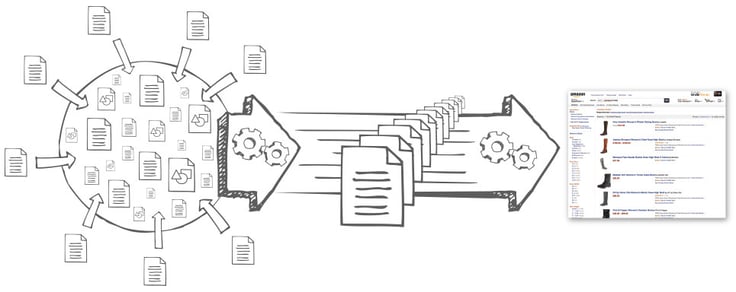
To offer a series of results useful to the users, searching among millions of items in an enormous database, it’s a very complex work. So complex that Amazon entrust the management of this activity to an external company named A9.com. In the last years sharpened its technology until they created a jewel to be sold. A9.com, as stated in their homepage, provides to “ manage product search and advertising technologies that are scalable, highly available, and cross-platform for our parent company, Amazon, and other clients.”.
The search engine algorithm has two fundamental roles:
- select the products to present to the user that is searching
- order them in a way that can offer useful search results
The first stage starts even before the user uses the keyboard: indeed, the algorithm collects and analyzes thousands of datas, among them the traffic of users that passed through the website and every product fiche. In this way, as stated in the A9’s website, the algorithm is ready to offer suggestion as soon as the clients start typing.

Fig. 1 Diagram of the two steps in the search engine of Amazon (ranking algorithm). From www.a9.com
The second step is that of presentation of results. These results appear according to different types of visualizations - depending on whether the user is searching in a specific department or in “All department”.
In the first case, the products are seen according to a list (this can be due to the fact that the user stands far from the purchase and that more products can be seen in the same space).
In the second case the products are presented in a table, with a bigger version of the images (maybe because the sales’ lead has a clearer idea in mind and it is better to see more detailed information).
According to the department in which the user is searching, the search engine takes different decisions. For example, the algorithm takes into account the “misspelling” in a particular context. In addition, once listed all the products, the user can decide whether to order them for “Relevance” or “Featured”.
To sum up, we can say that there are three elements that you have to keep in mind when you talk about the A9 search engine:
- Amazon has as its main goal the maximisation of the incomes coming from any client (RPC: Revenue Per Customer)
- Amazon recognizes thousands of searching data of its users
- the A9 search engine has as its main goal that of put together point 1 and point 2.
The knowledge of the mechanism used can be useful to train yourself in order to visualize better your products.

